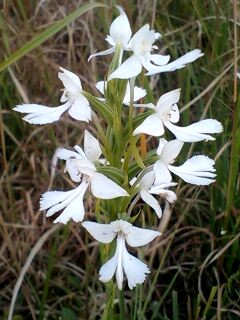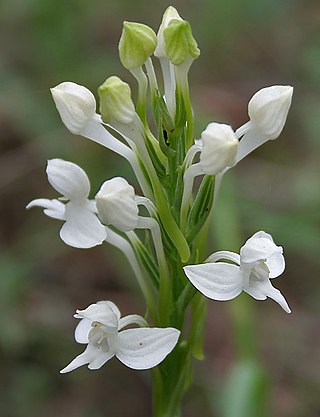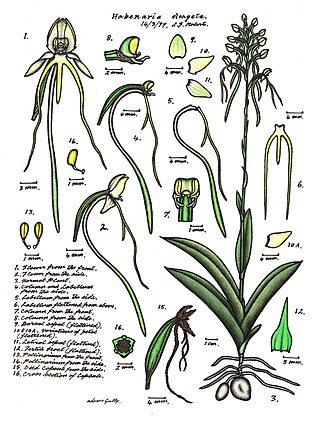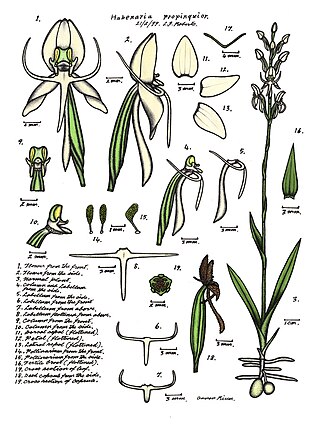
Habenaria, commonly called rein orchids or bog orchids, is a widely distributed genus of orchids in the tribe Orchideae. About 880 species of Habenaria have been formally described. They are native to every continent except Antarctica, growing in both tropical and subtropical zones.

Habenaria dentata is a species of orchid native to the Himalaya, China, India, Indochina, Thailand and Myanmar. It is also found at Phalee. The whole plant is about 35 to 80 cm in height. It has a smooth round tuber that give rise to a single plant. Lower part of stem sheathed, middle leafy and upper part bracteate. Leaves 4 to 6 cm long, oblong to elliptic, 5 nerved, sometimes 7 also, the base of the leaf narrowed into a long tubular sheath. Spike 4 to 8 cm long, laxly flowered. Sepals sub-equal, broadly ovate, acute, spreading, the lateral pair sub-erect. Petals narrowly oblong, sub-acute, curved inwards, shorter than the sepals. Lip as long as the sepals, variable in breadth, with large cuneate or rounded, fimbriate or crenate side lobes and a small oblong entire apical lobe. Spur infundibuliform at the base, slender laterally compressed, geniculate, sub-clavate below the knee, longer than the shortly stalked beaked ovary. Stigmas separated by the area in the centre by the orifice of the spur. It generally blooms in August- September.

Habenaria roxburghii, commonly known as Roxburgh's habenaria, malle leena gadda and as chekku dumpa in Telugu, is a species of orchid found in southern India. It is a tuberous terrestrial herb, 250–350 mm (10–10 in) tall. There are two or three more or less round leaves, about 70 mm (3 in) long and 50 mm (2 in) wide lying flat on the ground. The flowers pure white are arranged in long, dense cluster up to 80 mm (3 in) long. The sepals are broad egg-shaped, about 8 mm (0.3 in) long and the labellum has three lobes. The middle lobe is 8 mm (0.3 in) long and the side lobes are small. The species is usually found in shady places in the undergrowth of forests and is found in the Eastern Ghats.

Diuris alba, commonly called the white donkey orchid, is a species of orchid which is endemic to eastern Australia. It has up to three leaves, and a flowering stem with up to seven white flowers with purplish markings.

Habenaria chlorosepala, commonly known as the green-hooded rein orchid, is a species of orchid that is endemic to a small area in far north Queensland. It has two or three leaves at its base and up to twenty small green and white flowers.

Habenaria elongata, commonly known as the white rein orchid, or Kimberley spider orchid, is a species of orchid that is endemic to northern Australia. It has up to four leaves at its base and up to twenty small white flowers with yellowish tips and thread-like lobes on the labellum.
Habenaria euryloba, commonly known as the small rein orchid, is a species of orchid that is endemic to a small area in far north Queensland. It has two or three leaves at its base and up to twenty small white flowers with a trident-like labellum.

Habenaria exilis, commonly known as the wispy rein orchid, is a species of orchid that is endemic to a small area in far north Queensland. It usually has two leaves at its base and up to fifteen tiny whitish flowers.
Habenaria ferdinandi, commonly known as the yellow rein orchid, is a species of orchid that is endemic to the Northern Territory. It usually has two leaves at its base and up to fifteen tiny yellowish green, strongly scented flowers.
Habenaria fuscina, commonly known as the green rein orchid, is a species of orchid that is endemic to Cape York Peninsula. It has two or three leaves at its base and up to fifteen small green and white flowers with a labellum shaped like a trident.
Habenaria halata, commonly known as the sweet rein orchid, is a species of orchid that is endemic to northern parts of the Northern Territory. It has two or three leaves at its base and up to eighteen small white, sweet-smelling flowers with a labellum shaped like a trident.
Habenaria hymenophylla, commonly known as the coastal rein orchid, is a species of orchid that is endemic to northern Australia. It up to eight leaves scattered along the stem and up to thirty smelly green and white flowers.

Habenaria propinquior, commonly known as the common rein orchid, is a species of orchid that is endemic to north Queensland. It has two to four leaves at its base and up to thirty white flowers with thread-like lobes on the labellum.

Habenaria rumphii, commonly known as the stiff rein orchid, is a species of orchid that is widespread and common in Southeast Asia, New Guinea and northern Australia. It has six or seven leaves on the lower part of its stem and up to thirty white flowers with one long and two short lobes on the labellum.
Habenaria macraithii, commonly known as the whiskered rein orchid, is a species of orchid that is endemic to a small area in far north Queensland. It has up to eleven scattered leaves and up to twenty five relatively large green flowers with thread-like petal lobes.
Habenaria ochroleuca, commonly known as the sickle orchid or sickle habenaria, is a species of orchid that is endemic to northern Australia. It has two or three broad, glabrous leaves and up to twenty five white flowers on a flowering stem with many overlapping bracts. The side lobes of the labellum curve upwards.
Habenaria praecox, commonly known as the early rein orchid, is a species of orchid that is endemic to the north coast of Queensland. It has between two and four narrow, upright leaves at its base and up to thirty five small white flowers with a green dorsal sepal.
Habenaria triplonema, commonly known as the twisted rein orchid, is a species of orchid that is endemic to northern Australia. It two or three leaves at its base and up to twenty five yellowish, strongly scented flowers.

Peristylus maingayi, commonly known as the white ogre orchid, is a species of orchid that is native to southern Indochina, New Guinea and north Queensland. It has two or three broad leaves near its base and up to fifteen small white flowers that are tube-shaped near the base and have a three-lobed labellum.
Habenaria vatia, commonly known as the curved rein orchid, is a species of orchid, that is endemic Queensland where it is only known from a small number of islands. It has between three and five leaves at its base and up to twenty-five small white flowers with a relatively long green and white nectary spur.










